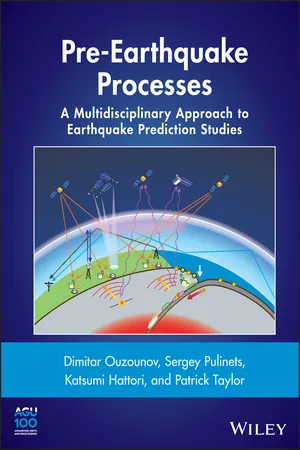ABSTRACT
Earthquake prediction must specify the time, epicenter, and size of an impending earthquake with useful accuracy. Among the long‐, intermediate‐,and short‐term predictions, only the latter is meaningful for directly protecting human lives and social infrastructures. Globally, seismologists running national earthquake prediction projects have long been pessimistic about short‐term prediction. In recent years, however, positive signs for short‐term predictability are emerging from diverse scientific communities. This article is a summary of the history and new directions of international cooperation in earthquake prediction research.
Modern earthquake seismology may be said to have started in California by the advent of elastic rebound theory after the 1906 M 8.3 San Francisco earthquake [Reid, 1910]. The theory stipulates that rocks on opposite sides of a fault subjected to shear stress slowly deform until their strength is exceeded, thereby producing an earthquake. Stress is accumulated over many years but is released instantly. This idea has since been the theoretical guideline for earthquake generation. In the following several decades, however, no serious scientific attempt for earthquake prediction had been undertaken. In the 1960s, national projects for earthquake prediction started in several countries, including Japan, former USSR, China, Taiwan, and the USA. The reason why this happened more or less simultaneously is not clear. Perhaps it was because scientific activity recovered following World War II. This development was aided by the Worldwide Standardized Seismograph Network (WWSSN) for nuclear blast detection [Bolt, 1976].
In Japan, the report “Prediction of earthquakes—progress to date and plans for further development,” known as the “Blue Print” [Tsuboi et al., 1962] appeared in 1962. Its content was essentially empirical but covered all possible items for monitoring, such as crustal movements, tides, seismicity, seismic wave velocity, active faults, geochemistry, and water‐level changes in boreholes, including even geomagnetism and geoelectric currents. Actual funding for earthquake prediction started in 1965 and has continued until now through consecutive 5‐year plans. Russia has a similar long history of earthquake prediction, dating back to the days of the former USSR. In China, the China Earthquake Bureau (CEA) has been responsible for earthquake prediction since the late 1960s. In the USA, the National Earthquake Hazards Reduction Program (NEHRP) was proposed in 1965, but it was not until 1977 that it was authorized by Congress. Taiwan, before the 1999, Chi‐Chi (or 921) M 7.3 earthquake, relied largely on fire fighters, police, and military at emergencies or natural disasters. After the 1999 earthquake, they established a permanent search‐and‐rescue team and an early‐warning system.
The International Commission on Earthquake Prediction was set up 1967 under the auspices of the International Union of Geodesy and Geophysics (IUGG). The IUGG is the world’s largest organization of geophysics. Optimism prevailed globally [Press, 1975] in the early 1970s due, for instance, to the apparent success of the dilatancy diffusion model [Sholtz et al., 1973], which appeared to explain all the precursory phenomena such as anomalous uplift, seismic‐wave velocity change, etc. Dilatancy is the volume increase due to generation of microfractures under high stress and diffusive influx of water into them was considered as the cause of lowering of rock strength, facilitating earthquakes. The success of long‐, intermediate‐, and short‐term predictions of the 1975 M 7.3 Haisheng earthquake also boosted optimism, but that optimism proved ephemeral. The seismic‐wave velocity changes predicted by the dilatancy diffusion model were not supported by accurate measurements in California [McEvilly and Johnson, 1974] and the CEA failed to predict the 1976 M 7.8 Tangshan earthquake [Chen et al., 1988]. In the USA, the Parkfield earthquake, predicted to occur before 1993, did not occur until 2004 [Langbein et al., 2005]. In fact, no internationally accepted prediction by any national earthquake prediction projects proved successful. This led to a totally pessimistic outlook, not only by scientific and social communities but also by governments, and this pessimism [Evernden, 1982] has essentially lasted until today. The 2011 M 9 Tohoku‐Oki earthquake occurred during the seventh five‐year prediction research program, after which the seismological communities in Japan completely gave up official short‐term earthquake prediction research.
During the same period, mainly in the 1970s, the plate tectonics concept became established. As is well established, according to plate tectonics theory, Earth’s surface layer is composed of about ten slowly moving (<10 cm year−1) plates (<150 km thick) and their interactions cause the whole range of tectonic processes observed, from mountain building to earthquakes [e. g. Uyeda, 1977; Turcotte and Schubert, 1982]. For geoscientists, including seismologists naturally, plate tectonics was an eye opener towards a more global view, as seismologis...
